What Do You Know About Fractions
When it comes to teaching maths at home, it'due south fractions your kids and y'all, will probably struggle with most. With words like numerator, improper, vinculum and others making their way into homework and school reports, sometimes fifty-fifty the number of terms relating to fractions for kids can all seem a little overwhelming for parents.
Knowing how to teach your kid fractions at home tin can just be difficult. Simply having taught in schools and in homes, we've been there and done it and can reassure yous now – at that place is a way through, yous but have to take it pace by step.
Bound to the fraction for kids help that yous need
Fractions in a nutshell – The things y'all may accept forgotten since school!
We understand that fractions can be frustrating for both y'all and your child, so here'south everything you need to know about them in brief!
What is a fraction?
Fractions are used to represent smaller pieces (or parts) of a whole.
The parts might make upwardly one thing, or more than than one thing. Either way, altogether, they make up what's called a whole.
Information technology'southward important to note that a whole tin mean more than one thing. It's useful to recall of a sweet shop as an illustration. For sharing a singular whole amount, you can think of a chocolate bar, a cake bar, or muffin. For group an amount into fractional parts, you can imagine a bag of sweets – there are lots of sweets in the pocketbook, merely you need all of them to make up the whole bag.
What is a child friendly definition of a fraction?
A simple definition of a fraction for children is:
A fraction is any part of a group, number or whole.
What are the parts of a fraction?
A fraction has three parts. They are:
The numerator which is the number above the bar.
The denominator which is the number beneath the bar.
The vinculum which is the bar separating the ii numbers.
What is a unit fraction?
A unit fraction with 1 as its numerator (top number), and a whole number for the denominator (lesser number).
Read more than: What is a Unit Fraction
What is a not-unit fraction?
A non-unit fraction is a fraction with a number greater than 1 as its numerator (meridian number) and a whole number for the denominator (bottom number).
Using objects to visualise fractions
When you're starting out with educational activity children fractions, objects or pictures of objects are a bang-up style to empathise how they work.
Start with concrete items, like food or counters – yous can use pasta pieces or dried beans in place of counters – so draw them equally pictures.
Once you've got this down, y'all tin can move onto using rational numbers (the fancy name for fractions) to correspond them. Learning fractions in this gild makes information technology easier to work out fractions of natural numbers later on.
The virtually important matter to think when you lot're dealing with fractions is to get ho-hum.
There'southward so much information to procedure! Even if something seems easy, accept the extra time to really empathize the bones concepts behind fractions. It will brand life a lot easier when y'all come up to more complex problems that involve converting between fractions, decimals and percentages subsequently on.
Find out more than well-nigh why nosotros apply concrete resources in maths.
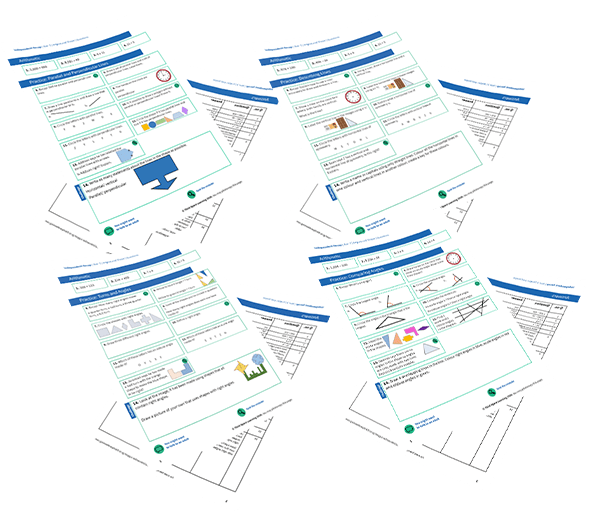
Understanding and Comparing Fractions Worksheets
Download these FREE agreement and comparing fractions worksheets for Year 3 pupils, intended to help pupils independently practise what they've been learning.
Examples of fractions in everyday life
You may not even notice, just fractions are all around u.s.a.! Some examples of everyday fractions include:
- Splitting a bill at a restaurant into halves, thirds or quarters
- Working out toll comparisons in the supermarket when something is one-half price
- Figuring out amounts in the kitchen, for instance a recipe could serve 10 people but there are but iv eating, and this means you'll need fractions to figure out the correct amount
- Adding up monetary amounts
- Looking at time! Half an 60 minutes and quarter by are both common things to hear where time is concerned!
Why are fractions and then tricky in primary school maths?
In the commencement years of school, you learn how numbers work. Y'all larn how to count, and that the number ane is equal to ane object, 2 is equal to two objects, so on.
You learn that when you count upwards, the numbers have more value. Then, simply when you lot think yous've got the hang of numbers, yous larn that at that place are other types of numbers out there, like fractions .
As a child, you are withal making sense of the world. So when you learn a set of rules (similar how to count with positive whole numbers), y'all concur onto them. The trouble? When y'all see things that don't fit the rules, it's much harder to understand.
Positive whole numbers (similar one, 2 or 65) are simple. They gain more value equally they go upwards, and they always mean the same thing (1 e'er ways 1, and ii ever means 2). They are too known as natural numbers . Fractions are known as rational numbers , and they follow different rules.
To cut a long story short, understanding how to do fractions can exist tricky for principal school children.
Fractions don't always mean the same thing. ½ of a cake is not the aforementioned as ½ of three cakes, or ½ of a pocketbook of 12 sweets! That's the commencement hurdle – the value of a fraction changes depending on how large the numerator (top number) is. Secondly, if the bottom number (the denominator) in a fraction gets bigger, the value decreases . On peak of all of that, names for fractions don't always sound like the number they stand for, similar an eighth for ⅛ or a quarter for ¼.
What does my kid need to know most fractions in KS1 and KS2?
With fractions for kids changing from year to yr throughout primary school, there is a lot to embrace in the blog, just to help yous out we've broken it downward on a year by year basis.
How to aid teach your child fractions in KSone
In KS1 almost the almost important thing you can back up your child with is their understanding that a fraction is a part of a whole. And a unit of measurement fraction is an equal part of a whole. If they tin can grasp this, they can move frontwards.
How to help teach your child fractions in Twelvemonth 1
When information technology comes to fractions, Twelvemonth one is all well-nigh getting to grips with the basics.
Fractions for a five or half-dozen year old is about how to utilise objects to find simple fractions similar ½ and ¼. The good news is that y'all tin can have a lot of fun with fractions at this historic period!
Get creative when helping them work out fractions
When demonstrating sharing into halves or quarters, it is vitally important to testify something existence shared into equal parts. Past doing this your kid volition be able to visualise what is happening when you are creating the fraction, and it volition assistance with their understanding.
Playdough is a great place to get-go when helping your child to work out fractions at a young age, as it is malleable and easy to suit into different fractions.
Even so, a firm favourite in primary classrooms is using food to represent fractions, and this is what you can do with your child at dinner time if pizza is on the menu!
Call up to emphasise the importance of every slice of pizza existence of equal size.
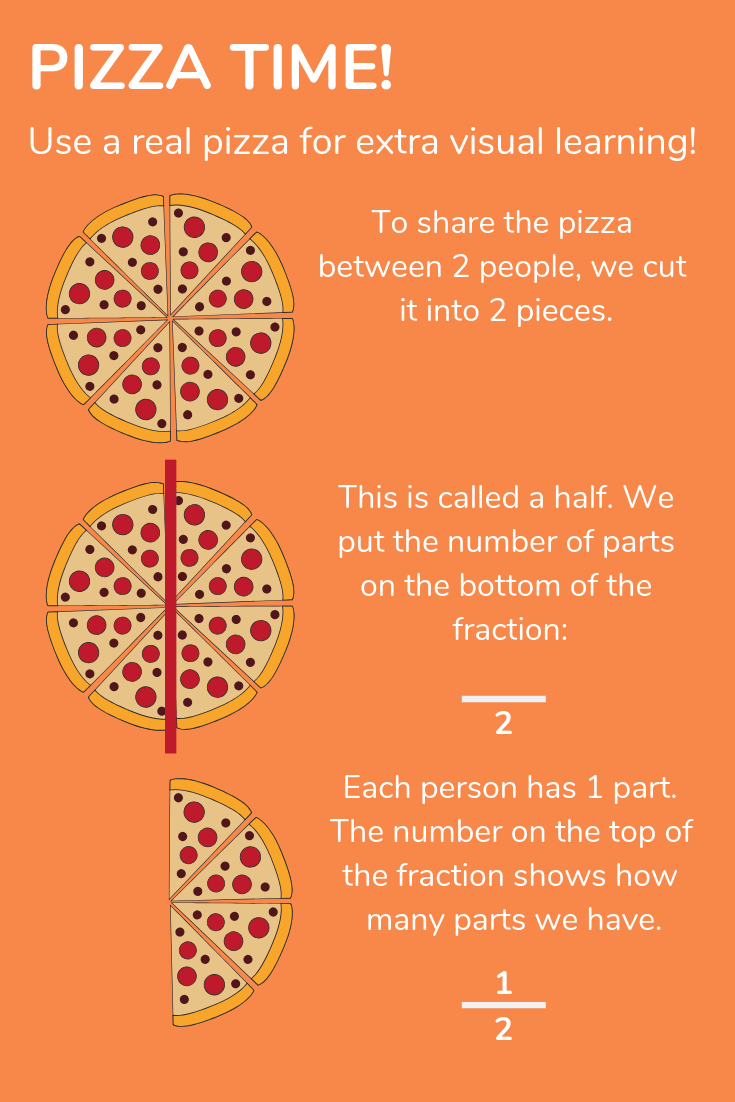
This is a simple visual representation of a fraction, and you can adapt it to try it with ¼ besides.
You can apply whatsoever food that's piece of cake to divide up, simply make sure to employ the language of fractions while you do this ( halves, quarters and split ).
The numbers your child will be working with for Year 1 fractions
In Twelvemonth 1 your child volition largely exist focused on the numbers 0-20, merely they may also piece of work on some specific larger numbers that are easy to tackle at this age. For case they may be able to tell you that one-half of 100 is 50, or that one quarter of 100 is 25.
How to aid teach your child fractions in Year two
In Year ii, there'south a firm focus on finding fractions of lengths, shapes and sets of objects.
Fractions for a 6 or 7 year quondam involves continuing apply of physical items to assistance them visualise fractions, and then now is a good chance to crack out the counters (or a suitable replacement) for some easy practice!
They'll also larn that some fractions are equivalent too – for example, 2/iv is the aforementioned every bit ½, or 2/half dozen is the same every bit ⅓.
Hither's how to explain information technology simply using counters (pasta or stale beans are a suitable replacement from the cupboard).
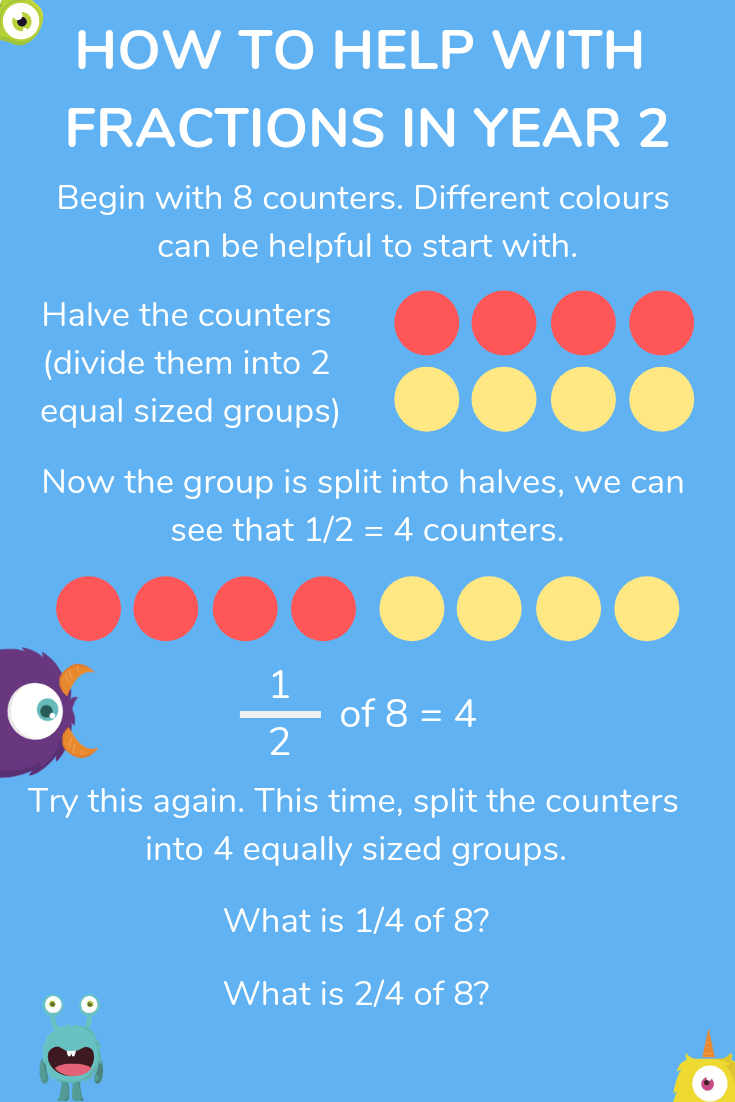
To help your child fully figure out equivalent fractions, point them out wherever you lot can, (specially ½ and two/four at this stage) as this connected repetition will help them to practise until they perfect their noesis.
Another piece of cake way to practise is to shade in different fractions of shapes, like this:
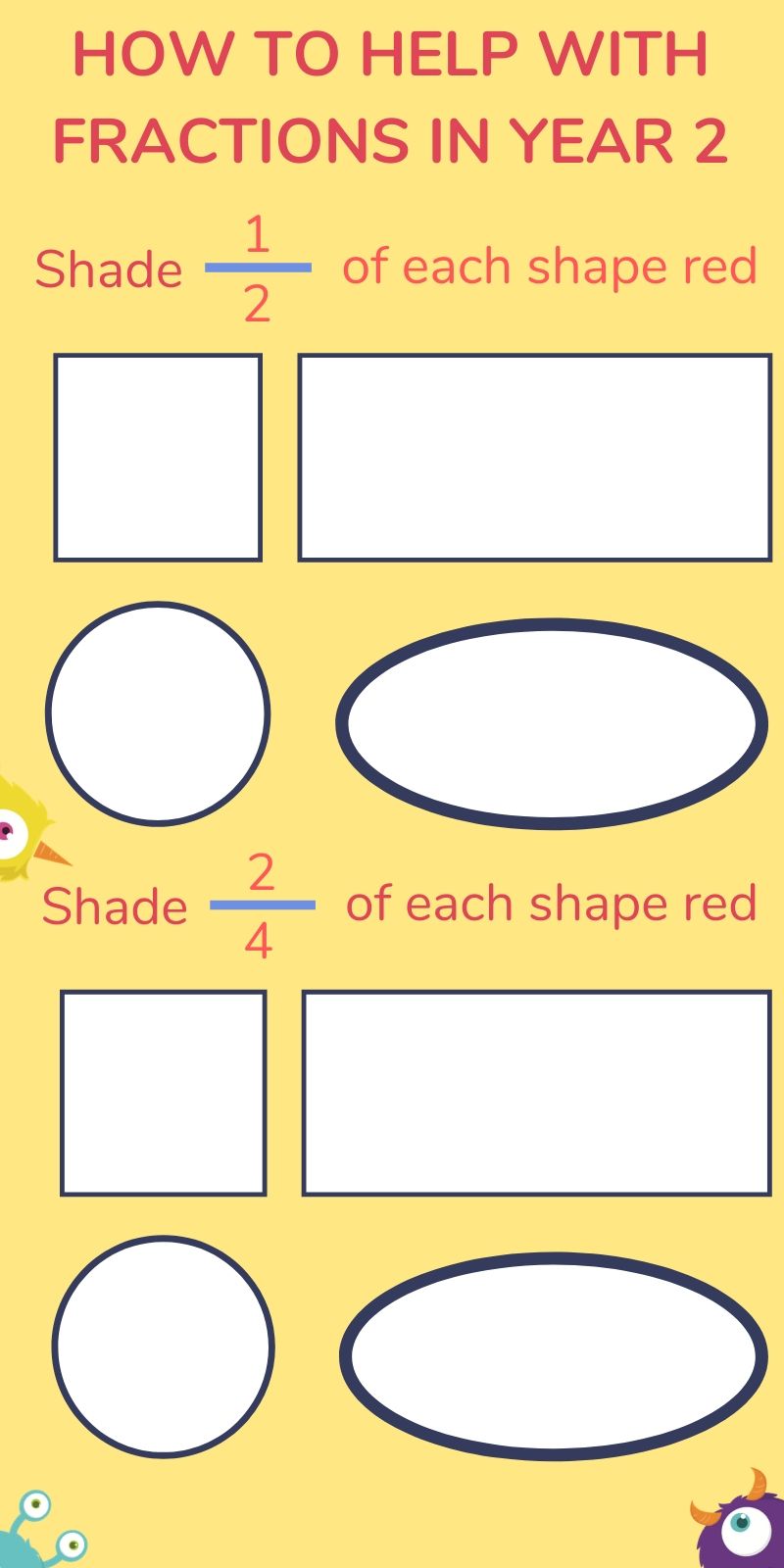
This simple, all the same visual method is a groovy way for your child to work on their fractions in Yr ii.
How to help teach your child fractions in KS2
KS2 is the time when fractions can go slightly tougher for your child, but with all of the help on offer below, you won't have any trouble helping them larn all nigh fractions at abode!
How to help teach your kid fractions in Twelvemonth 3
Fractions for 7 and viii yr quondam kids in Year 3 involves them starting to move away from using objects to understand fractions.
They will still use some visual aids when working with fractions, simply in that location is more of a focus on agreement how to write fractions equally rational numbers (the form you are used to seeing them in) too.
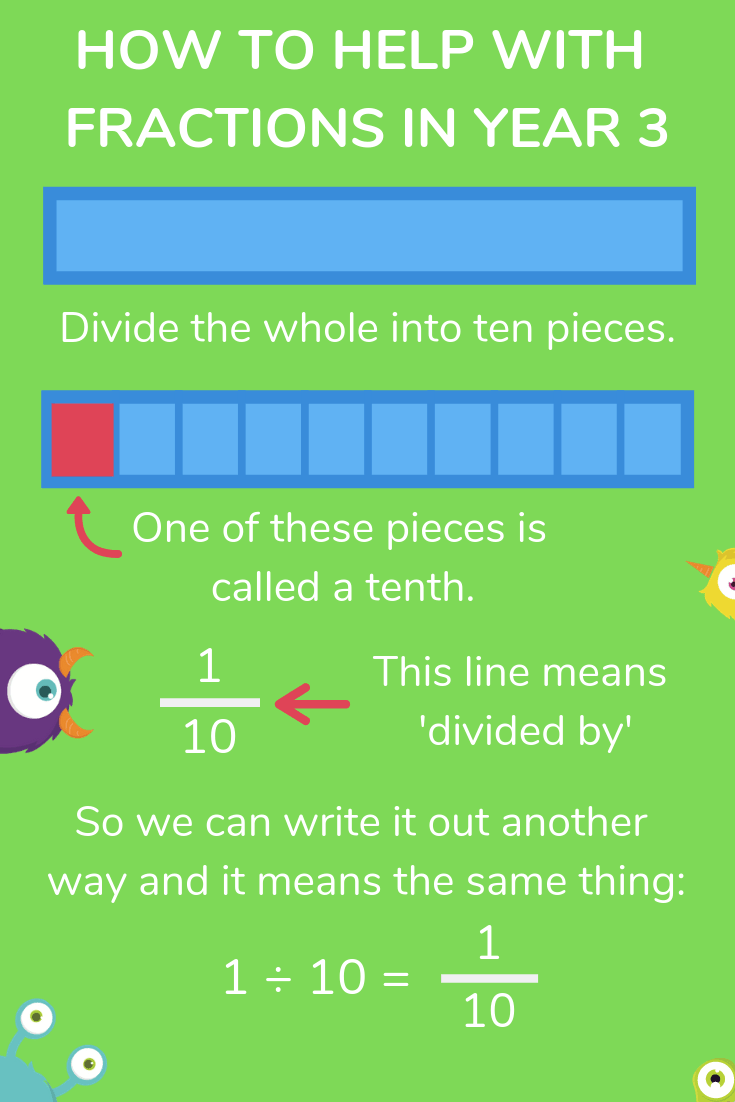
Side notation… the division symbol looks like ➗ every bit it shows a fraction bar (or – its proper proper name – a vinculum) with a dot above and below it; the top dot signifies a missing numerator and the lesser dot represents a missing denominator. The sectionalisation symbol itself is a constant reminder of the link between fractions and division!
Equivalent fractions in Twelvemonth 3
At this age, children also demand to know a few equivalent fractions with small denominators, and be able to put them in order.
Equivalent fractions is a existent spring for many children, and most teachers find information technology a existent stumbling block for many children in their classes.
However, there are three sure-fire ways of helping your kid understand how to do equivalent fractions in Year three, and yous can see them below!
Equivalent fraction playdough
This is a elementary, nevertheless very constructive action that can help your child to visualise equivalent fractions in a way that they will sympathise.
How to run the action
- Give your kid three evenly sized balls of playdough.
- Get them to intermission one ball downwards into halves, another into quarters and the 3rd into eight evenly sized pieces.
- Now, use a scale – preferably a balance scale – to bear witness that the half is equal to 2 quarters and four eighths. (Also, that a quarter is equal to two eighths, and that three quarters is equivalent to six eighths.)
- Y'all could get them to reform the 3 original balls of playdough, breaking them downwardly into three, six and nine equal pieces. Again, you can demonstrate that a tertiary is equal to two sixths and iii ninths, and that two thirds are the same as four sixths and six ninths.
Equivalent fraction newspaper strips
All yous need for this activity is a sheet of paper, some scissors, and a bit of patience when it comes to cutting the strips!
How to run the activity
- Firstly, cut some strips of newspaper. They must exist paper strips of equal length.
- Fold the first strip in half.
Fold the second strip into quarters.
Fold the 3rd strip into 6 equal parts or sixths.
Fold a fourth strip into viii equal parts or eighths.
Finally, fold a strip into twelve. - Next, work with your child to label the strips, so each role on the first strip has ½ written on each role, the second strip is labelled with ¼s, and and then on. Now, you / they can evidence that a half is equal to two quarters, three sixths, four eighths, and half dozen twelfths.
You tin can then bear witness that a quarter is equal to two eighths and 3-twelfths.
Yous could repeat the procedure again, folding equal length paper strips into three, six, 9 and twelve, showing that two sixths, three ninths and iv twelfths are equal to a 3rd.

Using the strips you've made, yous can do the same for ¾ and ⅔ too! You're off to the races!
Comparing, and calculation & subtracting fractions in Year 3
Of course, the value of a fraction depends on the numerator (the acme number) and the denominator (the bottom number).
Fortunately, in Year 3, you only demand to compare fractions with the same denominator, which makes things easier.
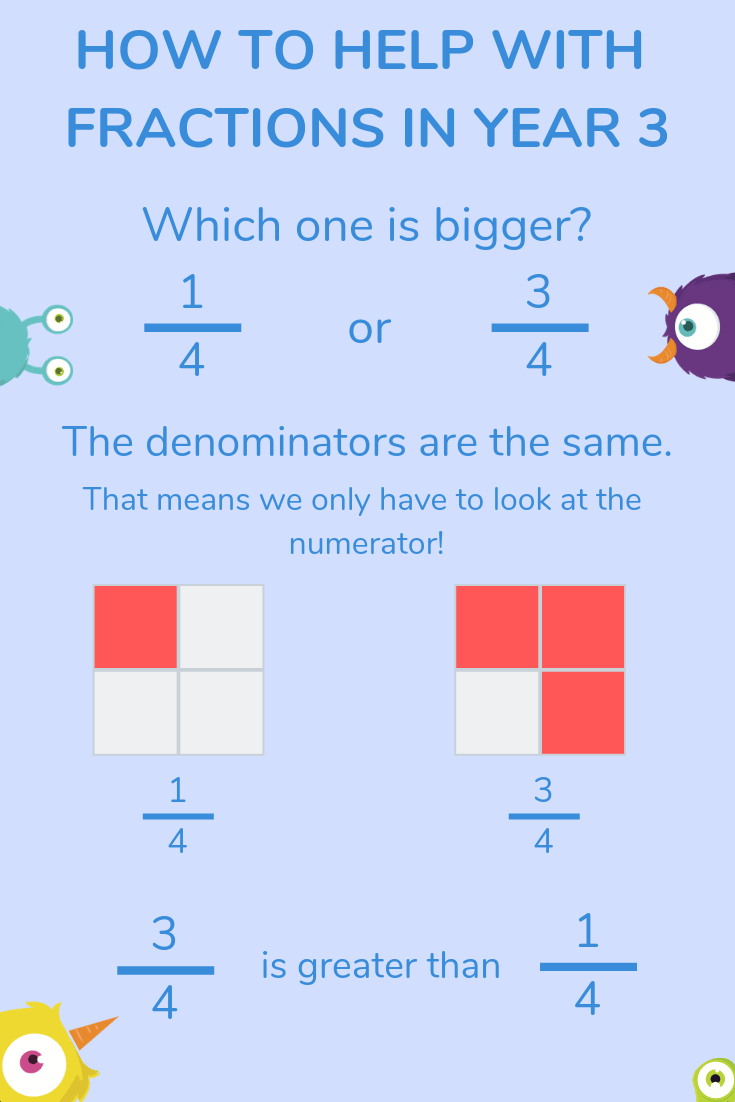
When the denominators are different, there are a few more steps to follow, which nosotros'll explain after on in this weblog.
You lot'll exist pleased to hear that calculation and subtracting fractions isn't too scary in Twelvemonth 3.
Every bit the denominators are the same at this betoken, you merely add the numerators, like this:
¼ + 2/four = ¾
Which tin can exist shown using newspaper strips again:

The principle is the same for subtraction in Year 3.
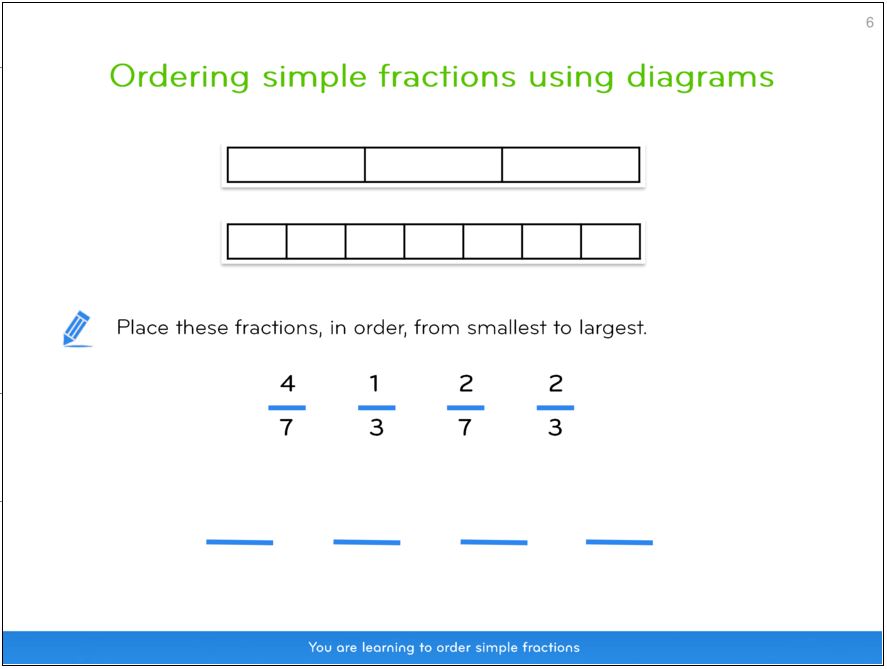
How to help teach your child fractions in Twelvemonth 4
In Year iv your kid should be beginning to understand the basics of how to do fractions, and they will have more of a focus on using abstract fractions.
It'due south likely that they won't be using as many counters and other physical learning resources, although it is still of import to weave these into their learning, significant y'all shouldn't stop practising with them at home!
Fractions for 8 and nine yr olds is about nailing the basics earlier everything gets a lot more complicated in year 5.
By the end of Twelvemonth 4, your child will need to know how to:
- Count up and down in tenths and hundredths
- Work out fractions of amounts
- Add and subtract fractions (aforementioned denominator)
- Recognise quite a few common equivalent fractions and decimals.
Fractions word issues in Twelvemonth four
At this point in primary school, word problems become more common, usually involving measurement units, like mm, cm, yard, km and g and kg, and money.
Working out fractions of amounts is much easier if you use bars to represent the unlike parts.
Take for instance the question of:
What is 1/6thursday of 1200m?
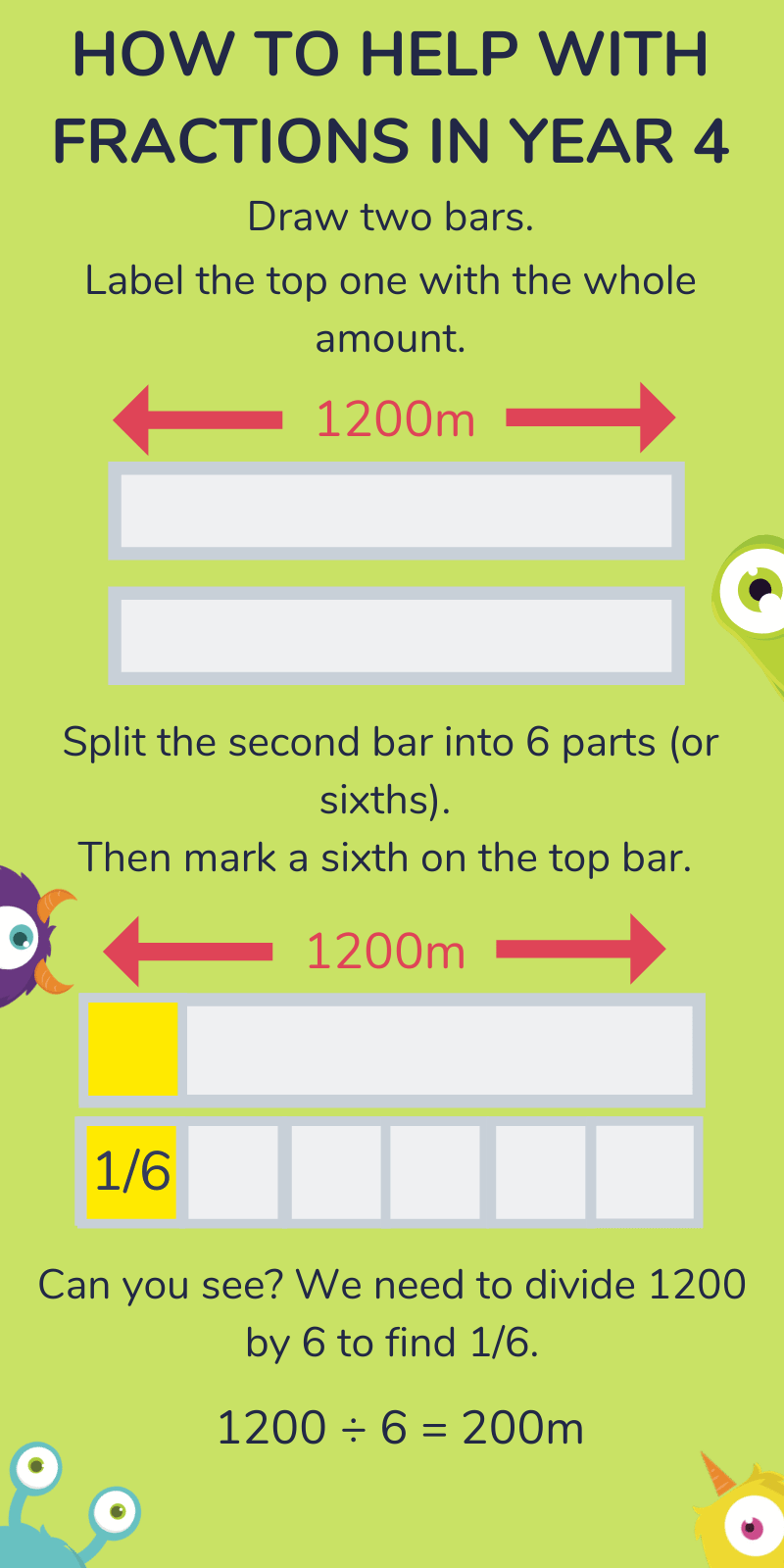
If you wanted to work out 2/six of 1200m, you'd merely multiply the respond for 1/6 by two. For iii/6, you lot'd multiply it by 3.
Bars work really well for learners who like to see things laid out visually. They can exist used for other areas of maths too – ranging from division, multiplication, improver and subtraction to ratio and proportion – not just fractions!
Equivalent fractions in Year 4
The word equivalent only means the same as .
In Year 4, your child needs to know the decimals (numbers with decimal points) that correspond to uncomplicated fractions.
You lot can piece of work them out manually (past dividing the numerator past the denominator), but it'due south a good idea to memorise the common ones so y'all can access them quickly.
| Fraction | Decimal |
| ½ | 0.v (or 0.50 – the value is the same) |
| ¼ | 0.25 |
| ¾ | 0.75 |
How to assistance teach your kid fractions in Year 5
Twelvemonth v is probably the nigh challenging year for fraction learning, and unfortunately other than difficult piece of work, there is non an easy way for 9 advertising 10 twelvemonth olds to acquire their fractions this year.
But if you really know the concept behind fractions (that they're parts of a whole and they have different rules to natural numbers ), then you'll be fine.
The reason that Year five can be tricky is that in that location's very fiddling concrete representation, A.K.A near of the pictures and items used to correspond fractions are now gone!
Your child volition start to add and subtract fractions with different denominators , which means there are a few more steps involved.
The linguistic communication used can be challenging too.
Make certain to use words like denominator, numerator, dissever, compare, society, improper fraction and mixed number often to go on cardinal vocabulary fresh in your child's mind, as this will stand them in practiced stead for the work they volition be doing throughout Year 5.
Comparing and ordering fractions in Year 5
Comparing and ordering fractions with the same denominators is relatively simple.
Even so, in Yr 5, you need to know how to compare and order fractions with different denominators.
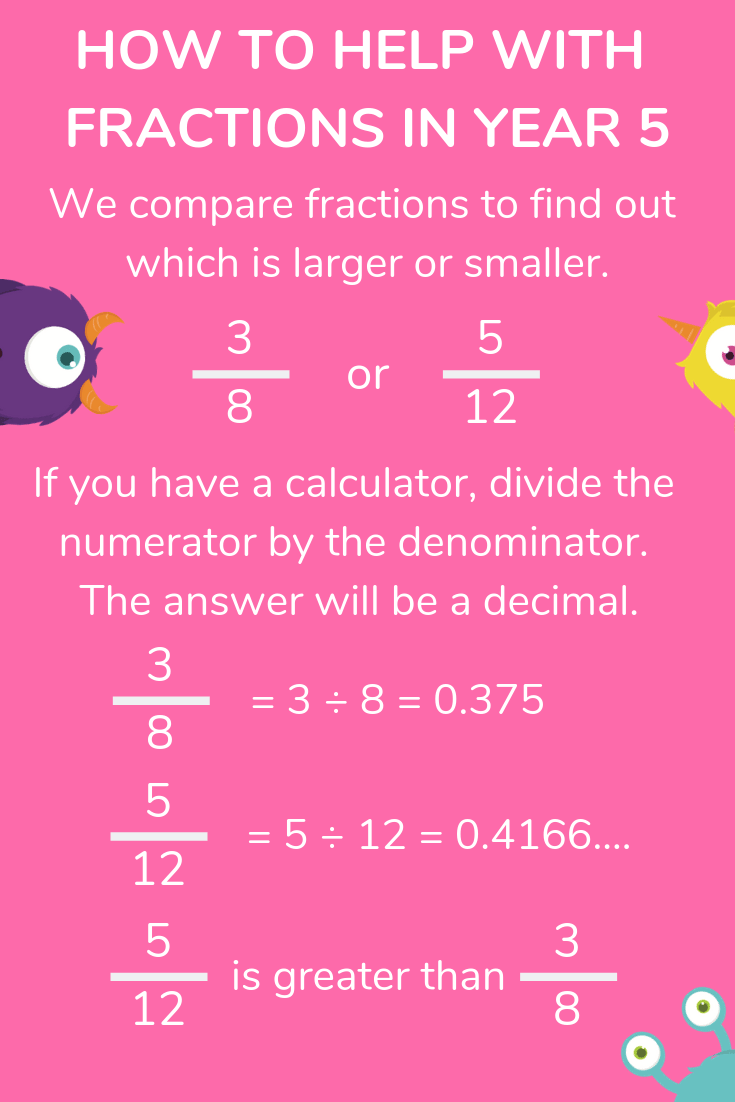
Virtually schools will not use the calculator strategy though, as calculators are not used in the Year 6 SATs (also known as the Cease of KS2 Assessments).
If your child is struggling to grasp the concept of comparison fractions with different denominators though, the figurer is a good place to start.
Reckoner free way to work out ordering fractions
The process of ordering fractions without a reckoner may have a little longer for your child to get to grips with, only it is something they will demand to know in Yr 5.
The image below demonstrates how to piece of work out ordering fractions if yous don't accept a estimator.
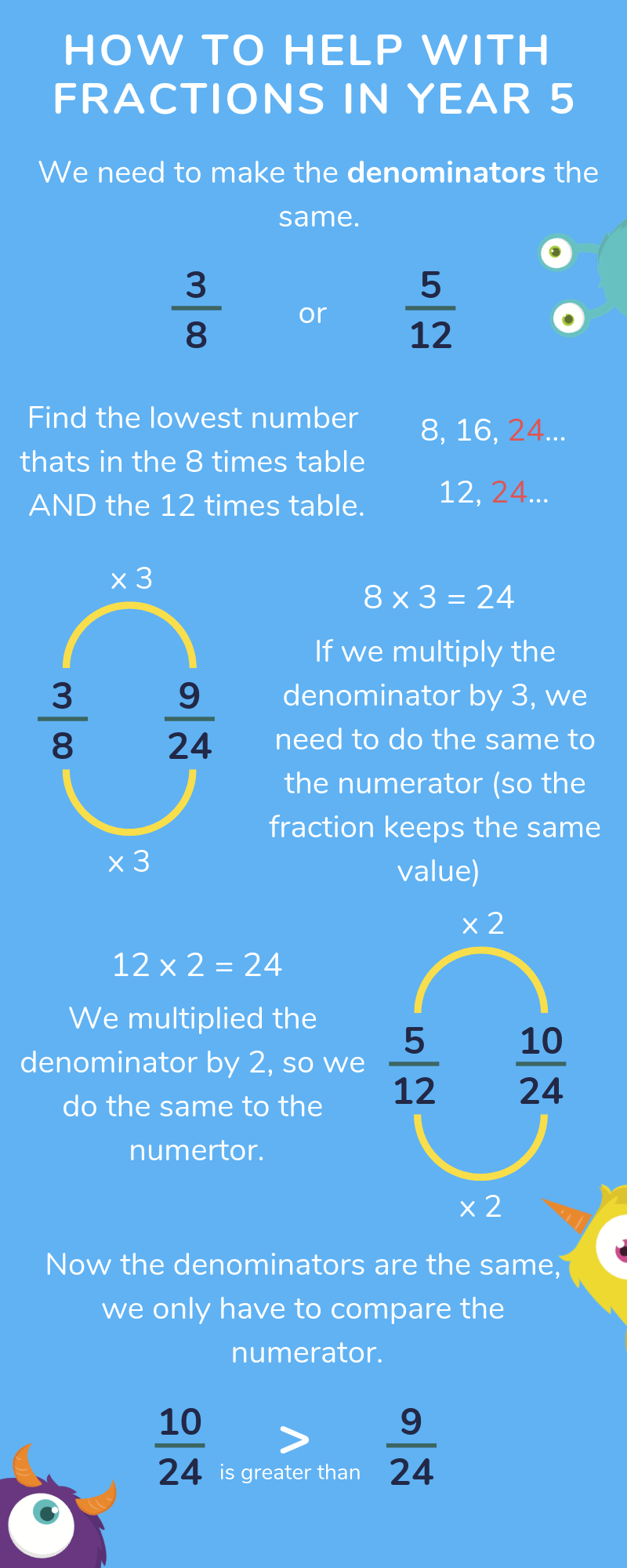
Ordering fractions tin can be made much quicker if yous know your equivalent decimals and percentages.
Hither are the equivalents y'all need to know in Year v.
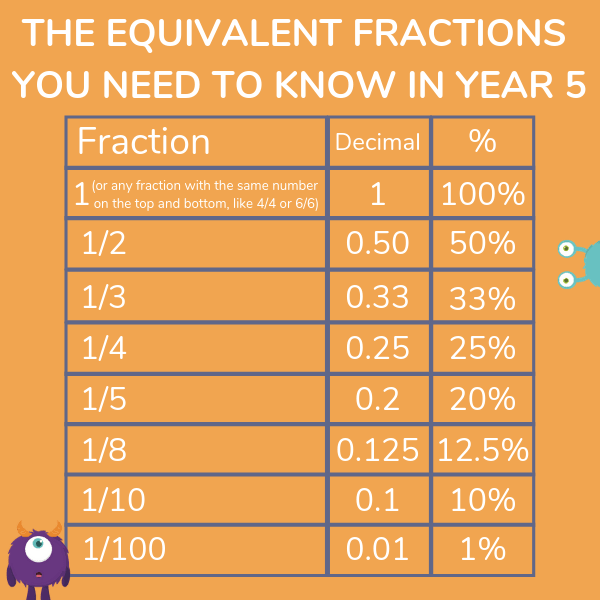
Mixed numbers and improper fractions in Year v
When you accept a whole number and a fraction side by side, like i ½ , it'southward called a mixed number . You can convert this into a fraction, but the numerator will be bigger than the denominator. In this instance 3/2. This is called an improper fraction (you may also hear it being chosen a meridian-heavy fraction).
Understanding how to do improper fractions is something that is important in Year 5, and it is something that you can assist your child to practise.
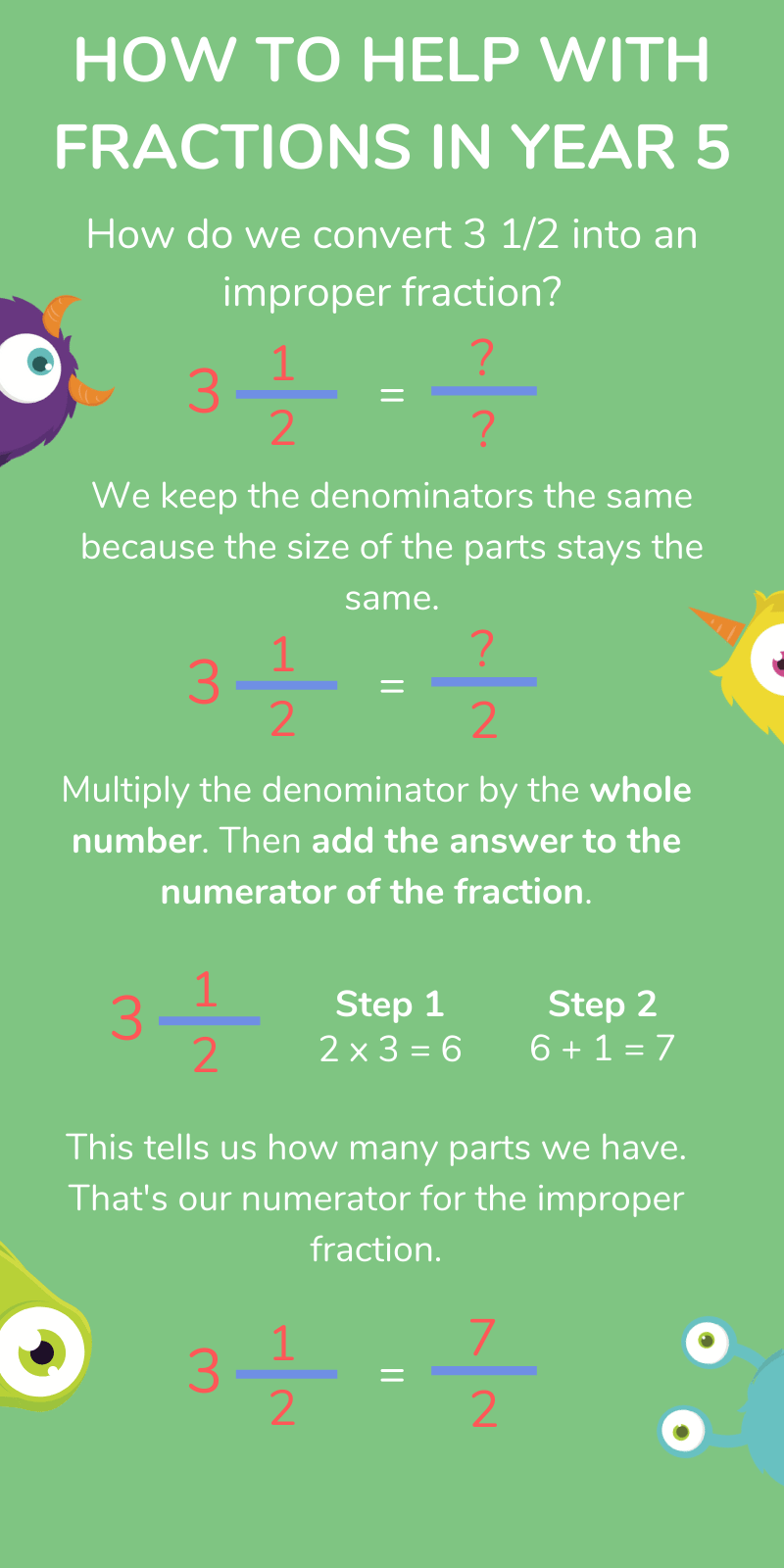
Calculation and subtracting of fractions in Yr v
Some other skill your child will learn in Yr five is how to add and subtract fractions.
Adding and subtracting fractions with the same denominator is simple as you merely add the numerators and go along the denominators the aforementioned.
⅛ + ⅜ = 4 8
Just, when the fractions have different denominators,they demand to be made the same before you go whatever further.
Twelvemonth v is a good fourth dimension to get used to finding mutual denominators (making the bottom number the aforementioned) as in Year 6, much of the fractions work your child volition practise relies on their ability to exercise this.
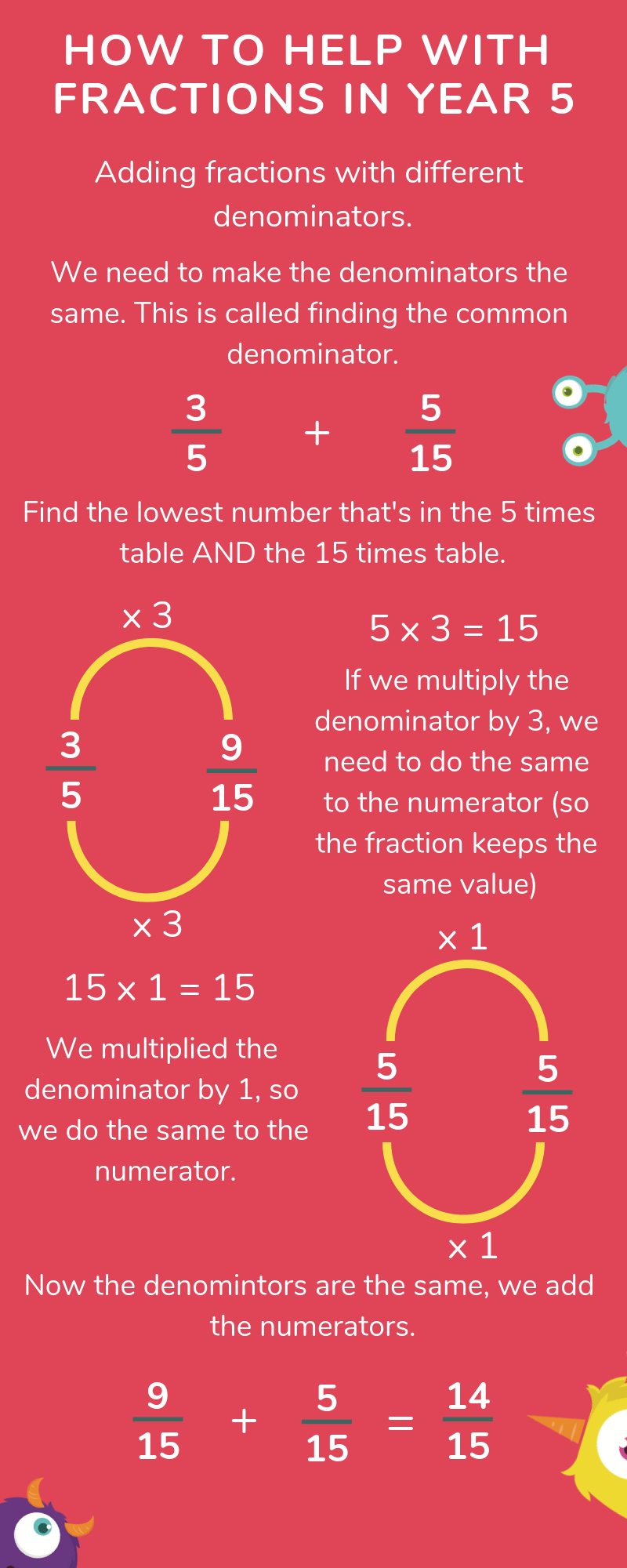
Multiplying proper fractions by fractions in Twelvemonth 5
Having learned an awful lot near fractions already by Yr 5, knowing how to times (multiply) fractions is relatively uncomplicated compared to all the other processes your child has learned by this phase.
You just multiply the numerators then multiply the denominators, like this:
2/four ten iii/v = 6/20
Multiplying fractions by whole numbers in Year 5
When you're asked to multiply a whole number by a fraction, information technology looks a little bit disruptive to a Year 5 kid. For case:
iii ten three/iv
To overcome this daunting problem, yous could begin by returning back to newspaper strips, like so:



Here it is of import to retrieve that the denominator remains the same. If that is proving a stumbling cake, you can curl out every maths teacher's best friend: pizza.
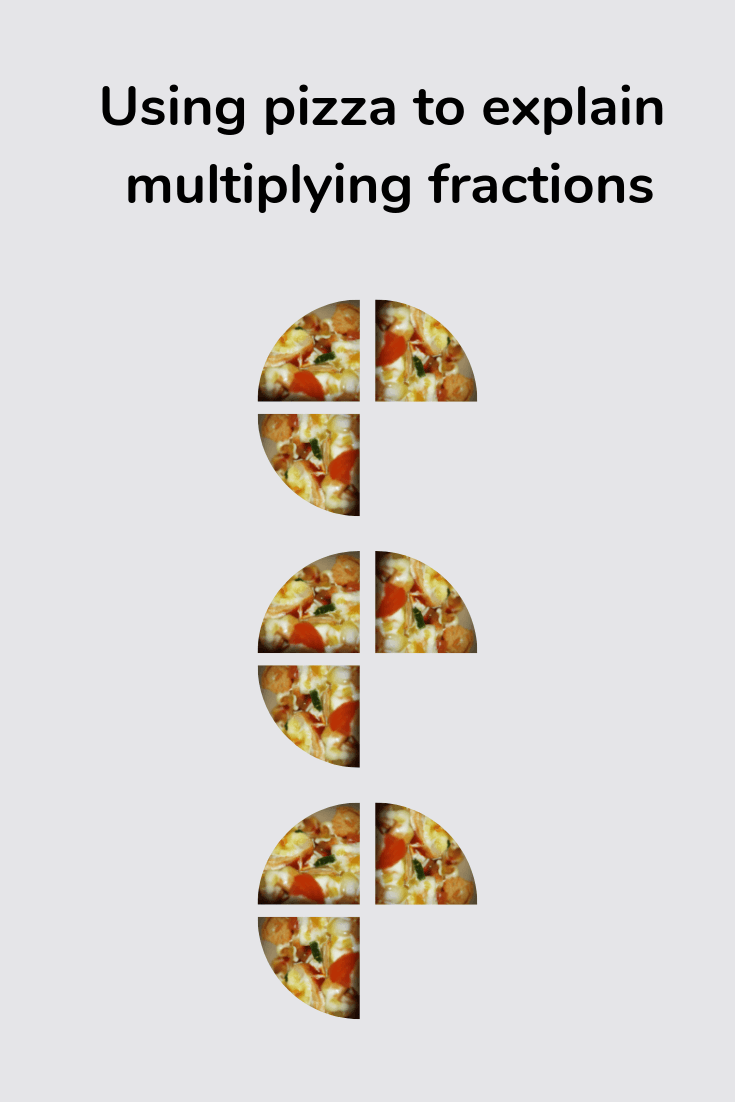
But if you remember one simple fact, information technology's a lot easier.
Any whole number tin exist made into a fraction by giving it a denominator of 1.
3 = 3/1
That's considering 3/1is the same as 3 ÷ i, which is 3.
The resulting equation is much easier to solve. Just multiply the numerators together, and so the denominators together.
3/one x iii/4= 9/4
How to assistance teach your child fractions in Yr 6
Past Twelvemonth 6, your child will have covered most of the fraction material they'll need in primary schoolhouse maths.
Although there are one or ii new processes to learn, it'due south important to revise the basics this year in time for the KS2 SATs in May – they always seem to come effectually much quicker than yous'd expect!
1 of the most important things to ensure your child is confident with is making different the denominators the same, as if this is the case they'll feel a lot more than sure of their abilities inside the next chapter of fraction work.
It'south like shooting fish in a barrel to feel overwhelmed by fractions in Year 6, but there are still things you tin do to assistance your child overcome any fractions frustration!
How to simplify fractions in Twelvemonth 6
A new requirement in Year 6 is to write fractions in their simplest form .
This only means that we employ the lowest possible numbers when we work out our fractions.
We do this to keep things unproblematic – it stops us from catastrophe up with fractions made up of huge numbers (which can be confusing).
Simplifying fractions is another area which highlights the importance of children mastering their times tables.
For example, even though we know that 2/4 is a perfectly acceptable fraction, we simplify information technology to one/2 to keep things easy (using our knowledge of the two times table and, consequently, halving).
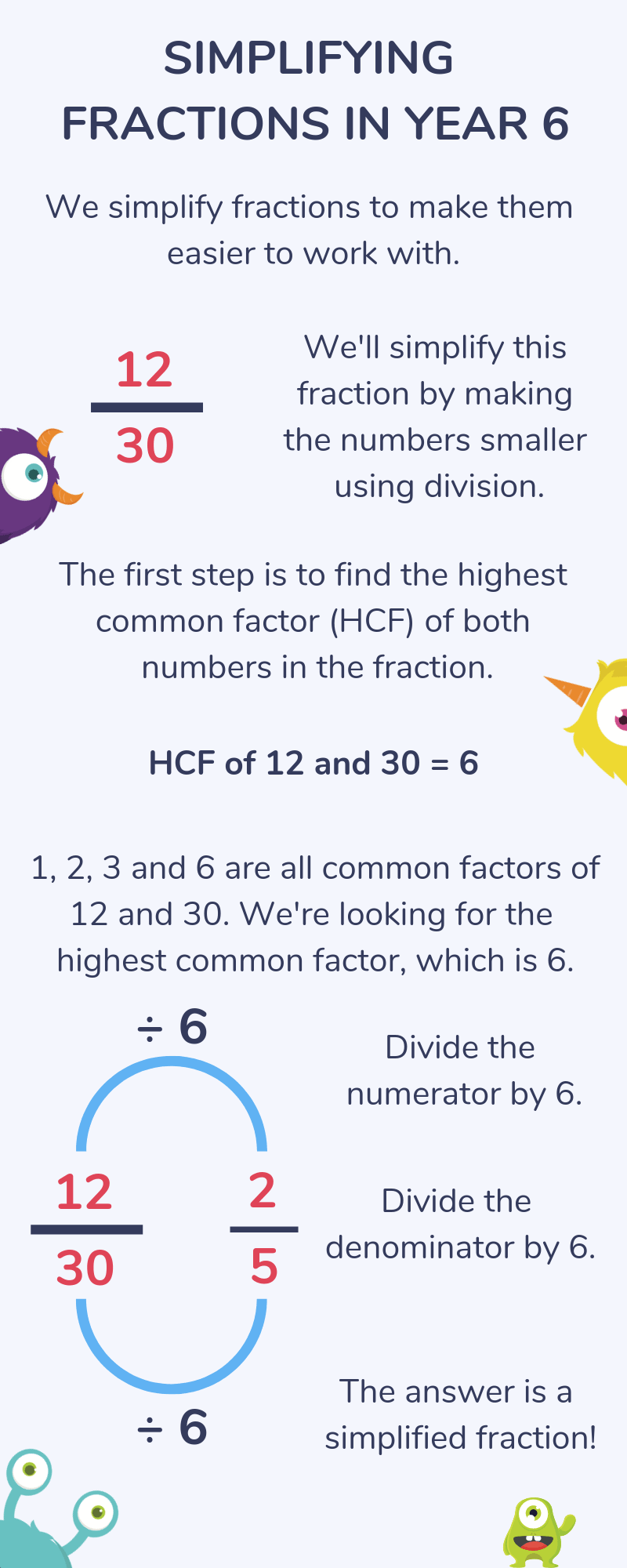
You can make simplifying fractions easy past practising finding the highest common factors of pairs of numbers.
A keen technique for finding factors are factor rainbows, an example of which tin be seen beneath.
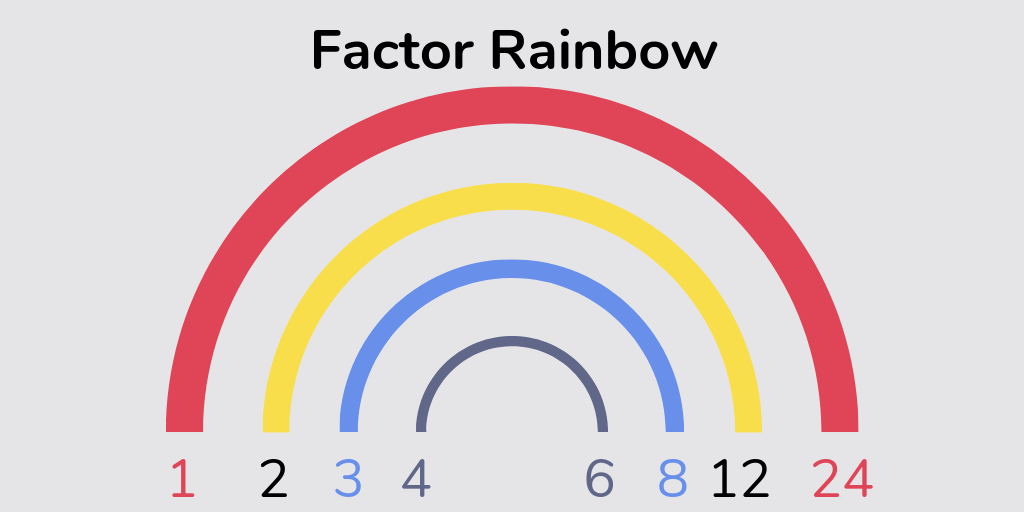
How to separate proper fractions by whole numbers in Year six
Dividing fractions is a simple procedure, as long as you remember that when you're using whole numbers in a fraction problem, you can put that number over i to go far a fraction also, similar this:
iii = 3/1
So if you're solving a problem like 3 ¾ , plough the 3 into a fraction offset.
three/1 / three/4
Next, flip over the second fraction (turning it into its reciprocal) and change the operation to multiplication.
3/1 ten 4/3
Now it'south a elementary multiplication problem, just multiply the numerators and the denominators to notice your answer.
3/1 x 4/iii= 12/3
Don't forget to simplify the respond! In this instance, the answer will be a mixed number.
12/three= 12 / 3 = 4
Fractions, decimals and percentages in Year 6
Fractions, decimals, and percentages all stand for parts, or pieces, of a whole and so it's non surprising that they're closely related.
Information technology'due south good to know how to get from ane to the other, especially when you lot're ordering or comparing amounts.
Your child should go to know the more common equivalents by heart (run across tabular array to a higher place) – and learn the strategies for finding mutual percentages.
For example, to discover 1% they must carve up the amount by 100, or separate the amount by ten and the upshot of this partition calculation past 10 again.
Converting fractions for KS2 SATs in Twelvemonth 6
Past the finish of Year 6, your child volition need to know how to catechumen fractions into decimals and decimals into percentages.
Converting fractions into decimals
Split up the numerator past the denominator.
If they do non know their equivalences or if it is a more obscure fraction (which it is unlikely to be), they should revert to using brusk division (otherwise known as omnibus-cease segmentation).
Converting decimals into percentages
Multiply the decimal by 100. For example, 0.79 would become 79%.
Converting percentages into decimals
Divide the pct by 100. And so, 87% would become 0.87.
Converting percentages into fractions
Put the percentage amount over 100 (due east.one thousand. 75% = 75/100), and then simplify it – in this case ¾ .
Although in that location are written methods for converting decimals dorsum into fractions, at this phase it'due south all-time to focus on what's required for the curriculum in master school maths and for the most part simple equivalences similar 0.25 existence ¼ will be all that is required (knowing the eighths is helpful as well such equally 0.375 being the aforementioned as 3-eighths).
It's worth as well reading this article on comparing fractions decimals and percentages.
Fractions in reasoning and problem solving in Year 6
In Yr 6, there are two papers (Paper 2 and iii) that your child volition have to take as part of their SATs.
These papers are about problem solving and reasoning. Fractions volition appear in Paper 1 (arithmetic) too, merely they tend to exist a little trickier when they're in context.
Get your child to have a go at the post-obit SATs questions to get a experience for the kind of give-and-take issues that come upwards.
Follow these steps to assistance make them a niggling easier:
- Read the whole question. Cheque how many marks there are.
- Read the question again, circling any important information (this could be words that give you a clue to the functioning needed, similar halve , share etc.).
- Decide which operation you need to apply (addition, subtraction, multiplication or division) and if you need to take more than one footstep to solve it.
- Apply the operations and steps you lot decided on.
- Double check the respond. Does it make sense in the context of the question?
Example SATs fractions questions for Yr half-dozen
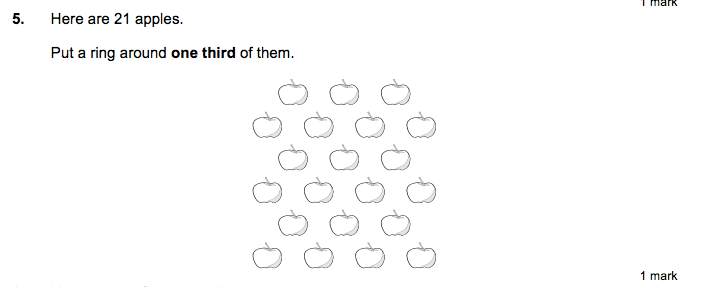
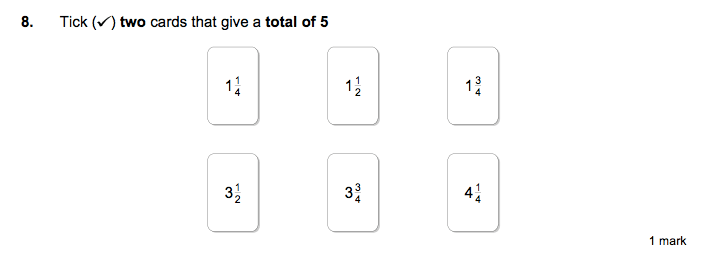

If you're struggling to support a child to understand and learn about fractions at home, help is at paw. We can provide affordable online maths tuition perfectly matched to your child's individual needs. If fractions is where they demand help, that'south what nosotros can spend the time with them on.
Online 1-to-1 maths lessons trusted by schools and teachers
Every week Third Space Learning's maths specialist tutors support thousands of pupils beyond hundreds of schools with weekly online ane-to-1 lessons and maths interventions designed to plug gaps and heave progress.
Since 2013 we've helped over fourscore,000 primary and secondary school pupils become more confident, able mathematicians. Learn more or request a personalised quote to speak to us virtually your schoolhouse's needs and how we can help.
Maths tuition for v to 12-year-olds focused on the national curriculum and delivered online
Source: https://thirdspacelearning.com/blog/how-to-teach-fractions-for-kids/
0 Response to "What Do You Know About Fractions"
Post a Comment